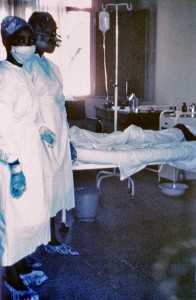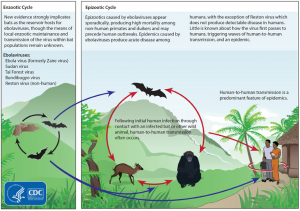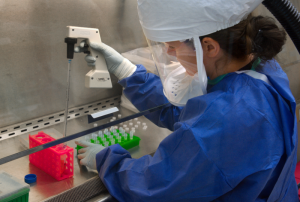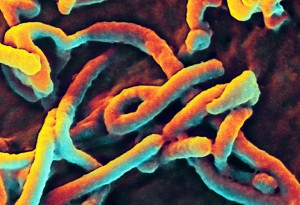
A new comprehensive study by Charles N. Haas, the department head of civil, architectural and environmental engineering, has suggested that the 21-day quarantine period currently used to ensure that an individual hasn’t contracted Ebola might not be sufficient to definitely conclude the person isn’t infected.
The study, titled “On the Quarantine Period for Ebola Virus” and published in PLOS: Current Outbreaks, studied the origin of the 21-day value and concluded that it is possible that the practice was put in place after the first Ebola outbreak in 1976 in the Democratic Republic of Congo and a 2000 outbreak in Uganda, both of which provided very little data to form proper health policies and practices. The research claims that there is still a 12 percent chance that an individual infected with Ebola will not show symptoms for 21 days.
The research comes amid the latest Ebola epidemic, which has claimed approximately 4,600 lives to date and continues to kill over 20 people every day in the West African countries of Liberia, New Guinea and Sierra Leone. According to the World Health Organization, the latest outbreak infecting and killing people is the worst in recorded history and has the potential to severely affect the economies of these three countries and turn them into failed states.
The global response to the outbreak has revealed several faults in the system, causing health workers and researchers to reexamine the practices and procedures for treating patients and preventing the spread of Ebola, which includes the practice of quarantining an individual suspected of exposure for 21 days.

While the latest outbreak is the most severe in known history, Ebola has ravaged Africa for the last 35 years. The first recorded outbreak of Ebola occurred in Congo in 1976 in a community close to the Ebola River, from which it got its name. It was then spread by close personal contact and by use of contaminated needles and syringes in hospitals and clinics. Despite the tremendous effort of dedicated researchers, the actual host carrying the virus was never found — although it was suspected to be a fruit bat. This outbreak was the first recognition of the disease and claimed 280 lives.
Since the first outbreak, the disease has occurred fairly regularly with a few intermittent periods of dormancy and one 10-year period between 1979 and 1989 during which Ebola was thought to be a disease of the past. The latest outbreak began Dec. 26, 2013, when a 2-year-old boy in a remote village in Guinea fell ill with an illness characterized by fever, black stools and vomiting and died two days later.
According to a report in the Science Journal, the virus then spread to Sierra Leone via a traditional healer who treated patients from across the border in Guinea where the Ebola outbreak had just started. Her patients flocked to her funeral and 14 others became infected as they prepared and buried the healer’s body and the disease spread exponentially from that point forward.

According to the Centers for Disease Control, the virus is spread by close contact with blood or body fluids (including but not limited to urine, saliva, sweat, feces, vomit, breast milk and semen) of a person who is sick with Ebola, needles and syringes that have been contaminated with the virus, and infected mammals such as monkeys, bats and apes.
Symptoms of the Ebola virus include fever, severe headache, muscle pain, weakness, diarrhea, vomiting, abdominal pain and unexplained bleeding from the eyes, nose, or other orifices and bruising. Symptoms may appear anywhere from two to 21 days after exposure to Ebola, but the average is eight to 10 days.
The Ebola virus works by entering the body and targeting several types of immune cells, which normally display signals of an infection to activate the white blood cells that could destroy other infected cells before the virus replicates further. With defective immune cells failing to give the right signal, the white blood cells don’t respond to infection and the virus can start replicating immediately and very quickly. As the virus travels in the blood to new sites, it damages the lining of blood vessels, causing them to leak. Damage to blood vessels leads to a drop in blood pressure, and patients die from shock and multiple organ failure.
The good news is that although the disease is severe, the virus is relatively difficult to transmit and its spread can be easily prevented by thoroughly washing one’s hands and avoiding contact with blood and bodily fluids of an individual suspected of having Ebola. In addition, the disease has a very small chance of becoming an epidemic in the U.S., despite the flaws in the system that were recently exposed, due to a strong healthcare infrastructure and ability to detect the disease at a very early stage.

In fact, the CDC updated their guidelines for health care workers when working with the disease or those infected within the past week. These guidelines include requiring workers to wear double gloves, full face shields, fluid-resistant gowns, waterproof boots and even an air-purifying respirator. These guidelines came after several health care works became exposed to the virus after dealing with infected patients in Dallas.
Health officials claim the reason for the severity of this outbreak is due to long held traditions surrounding burial customs such as washing the body of the deceased, the dramatic increase in population density in the affected West African countries since 1976, a weak healthcare system and that the disease is only contagious when the person shows symptoms, which takes 21 days.
The 21-day latency period is the main reason Ebola was able to spread to the U.S. and continues to be an issue in the West African countries. The 1976 and subsequent outbreaks brought forth the 21-day quarantine period and was seen as a surefire way to stop the spread. However, Haas’ research concluded that there is still a 12 percent chance that the 21-day quarantine period might be insufficient after considering all subsequent outbreaks that he believes the WHO and CDC may not have taken into account.
“While the 21-day quarantine value, currently used, may have arisen from reasonable interpretation of early outbreak data, this work suggests reconsideration is in order and that 21 days might not be sufficiently protective of public health,” Haas said.
However, Haas also claims that the benefits, risks and costs should be taken into account when making the decision to extend the quarantine period. Diseases that are extremely severe — such as Ebola — should have a longer quarantine period than those of less severity, but the benefit of extending the period should be weighed against the cost of enforcing the extended period and scientists and healthcare workers need to work with economists, lawyers and other professionals in order to develop an appropriate period that balances costs, risks and benefits.

To date, there is no cure for Ebola, but current treatment includes providing fluids, maintaining blood pressure, providing oxygen as needed, replacing lost blood and treating other infections that develop. New treatment options for Ebola are rapidly being developed, with medical trials for a possible Ebola vaccine taking place in West Africa in January 2015, according to WHO.
A treatment proven to work in Kent Brantly and Nancy Writbol, two American doctors infected with Ebola while working in Liberia, is ZMapp. ZMapp, being developed by U.S. company Mapp Biopharmaceutical, and Canadian Defyrus Inc., is a cocktail of genetically engineered antibodies that boosts a patient’s ability to fight off Ebola.
Until the treatments are developed and proven safe, health workers have to continue with traditional treatment of the disease. The U.S. Agency for International Development has announced that it is helping the African Union with $10 million of funding to mobilize an additional 100 African health workers to fight the outbreak.
So far, the U.S. has spent a reported $100 million responding to the outbreak. WHO has said that Liberia in particular needs better ideas for containing the disease, since conventional Ebola control interventions are not having an adequate impact in Liberia, though they appear to be working elsewhere in areas of limited transmission. WHO predicts Ebola will spread to as many as 20,000 people before it stops.

